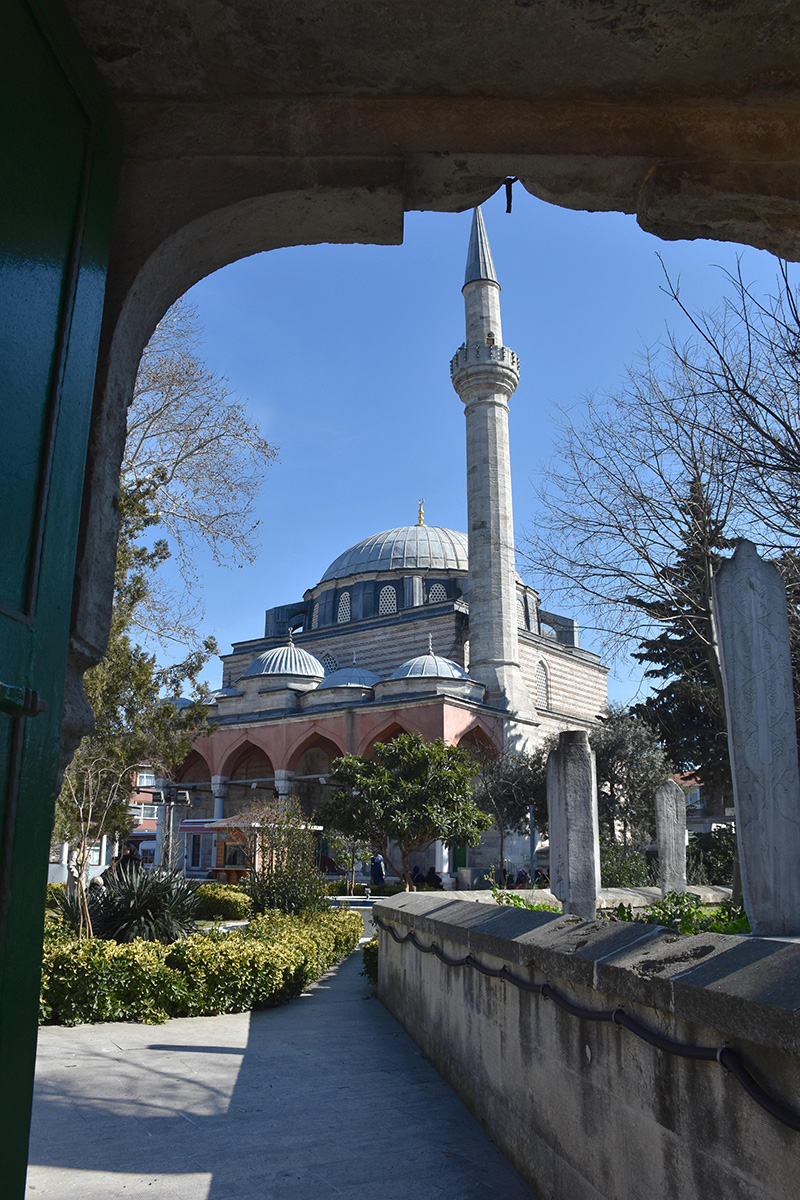
Dr.Webb, dokuzuncu ve onuncu yüzyıllara odaklanarak Bizans sarayının görsel ve törensel kültürü üzerine çalışmaktadır. Sanat Tarihi doktorasını 2022 yılında Stanford Üniversitesi’nden, yüksek lisansını ise 2013 yılında Tufts Üniversitesi’nden almıştır. Daha önce Stanford Humanities Center’da Tez Araştırmacısı ve Roma’daki Max-Plank Sanat Tarihi Enstitüsü Bibliotheca Hertziana’da Kress Institutional Araştırmacısı olarak görev yapmıştır. ANAMED’deki projesi doktora tezinin bir uzantısıdır ve hadımların Bizans sanatsal üretimindeki önemini aydınlatmaktadır. Hadımları kendi başlarına sanatsal hamiler olarak araştırıyor ve saray törenindeki çerçeveleme rollerinin karizmatik bir imparatorluk imajı yaratmak ve sürdürmek ve sarayı cennetin yaşayan bir görüntüsüne dönüştürmek için nasıl çok önemli olduğunu aydınlatıyor.
Kosmos Embodied: Eunuchs and Byzantine Art in the Ninth through the Twelfth Centuries
Lora Ellen Webb
The emperor looms large in Byzantine art and history. With his purple garments and red shoes, he is easily recognizable. In addition to his political and visual prominence, the emperor was also a quasi-theological figure. The Byzantines conceived of the earthly court as a reflection of the heavenly one. The emperor acted as Christ’s viceregent and became a kind of living image of the celestial ruler. The emperor’s special role was communicated in both images and in the ceremonial staging of the court.[1] In my book project, I look to the edges of this celestial mirroring, to court eunuchs who, in the Middle Byzantine period, played a crucial role in generating the correlation between heaven and earth. I see affinity between the ambiguous gender construction of Byzantine court eunuchs and concepts of framing, ornament, and artificiality. I gather visual representations, ceremonial roles, and artistic patronage to show how ornamentation, framing, and even omission were crucial components of Byzantine art and ceremony.[2]
While eunuchs seem foreign to us today, their history is as recent as it is ancient. Palatine eunuchs were common for much of human history. They were a regular feature of many ancient, medieval, and modern cultures. There are records of eunuchs among the Assyrians, Romans, Umayyads, and Mamluks. The enlightened upper classes of eighteenth-century Europe delighted in the incredible singing talent and outsized celebrity of the castrati. One of the last of these singers, Alessandro Moreschi, died only in 1922, and his voice survives in scratchy Gramophone recordings. Farther east, in China and Korea, court eunuchs were also prevalent; the last of them died in the late twentieth century. In Istanbul, Ottoman eunuchs served in the palace until the very end of the empire. One, Nadir Agha, retired to the Asian side of the city where he ran a dairy until his death in 1957.[3] Though the past decades have brought new attention to eunuchs, they had long been overlooked as subjects of history and, especially, art history. Thanks to ANAMED’s generous support of my research, this year I have been trying to see eunuchs and their contributions more clearly as I revise and expand my dissertation into a book manuscript. I have done so by considering the links between gender construction and artistic production and by considering the artistic patronage of eunuch courtiers, especially in comparison with their Ottoman successors.
Eunuchs were part of court hierarchy in the earliest centuries of the Byzantine Empire, but they reached the height of their power under the Macedonian Dynasty (867–1056). Certain roles in the palace administration were reserved only for castrated men. They cared for the imperial family, along with the silks, precious metalwork, and relics of the imperial household. Eunuchs were also critical to the ceremony of the court, where they visibly framed the ruler. One of the major sources for my project, the tenth-century Book of Ceremonies, regularly suggests that two eunuch sword bearers should stand behind the emperor in the golden throne room—the Chrysotriklinos. Bedecked in pearls and gold, such eunuch courtiers were often spatially closest to the emperor, mediating his space and presence. They served as his in-betweens, they introduced visitors into his presence, and they even placed the crown upon his head.
I use the word kosmos to describe the order the eunuchs imposed on the ceremony of the court. To the modern ear, a cosmetic ornament connotes something inconsequential or excessive, but to the Byzantines, even such ornament preserved the trace of cosmic order so important to imperial prestige. A kosmos can be a literal work of art, most often an icon revetment, that manifests the ideal of cosmic organization by properly framing and setting apart a charismatic center. Akin to Jacques Derrida’s concept of parergon, the kosmos is reliant on the center that it frames, but it is nevertheless a part crucial to a proper understanding of the whole.[4] Surrounding, clothing, and crowning the emperor, eunuchs set him apart as the central figure of the court. For all of their apparent visibility as framing figures in court performances, however, eunuchs expose a division between the ceremony of the court and its representation in artistic media: they are ever-present in the former, but rarely appear or are difficult to identify in the latter. By asking how this rift functions within Byzantine art and ceremony, I illustrate how the ambiguous appearance and inconspicuousness of eunuchs enabled revelation.
Most court eunuchs would have been visually recognizable. Castration usually took place before puberty, altering normal body development. Eunuchs might grow abnormally tall or carry fat in their breasts or hips. They did not develop beards and so appeared youthful beyond their intact counterparts. In life, eunuchs may have been easy to spot, but images of beardless men are often ambiguous. If a figure is beardless with gray hair, he is most likely a eunuch, but younger figures are trickier. Confronted with beardless attendants like those in Fig. 1, did a Byzantine viewer consider them to be young men or eunuchs? Further complicating the issue, Byzantine texts regularly conflate eunuchs, young men, and angels. The three were interchangeable within dreams and visions. The semantic instability of eunuchs challenges conventions of legibility in Byzantine art and reveals a new understanding of the import of ambiguity to the formation of charismatic imperial power. Eunuchs’ androgynous bodies blurred the line between male and female and were also likened to radiant angels, placing them at the boundary between the sexes and also between heaven and earth. I argue that this liminality was activated within the ceremony of the court to create a living image of heaven. Bringing this sense of instability to the visual record, I see beardless figures as an avenue to understanding a more capacious gender landscape, one in which a lack of clarity and a lack of stability was valued for its representative possibilities. I presented some of my findings related to the revelatory possibilities of eunuch courtiers in May 2023 at the NetMar International Congress “Rituals of Gender Staging and Performance in the Middle Ages” in Bamberg.

In Istanbul, I have devoted my time to looking for the traces of eunuchs throughout the city. One critical monument is the archaeological site of Küçükyalı. Alessandra Ricci has identified the site as the Satyros monastery, which was built by the eunuch patriarch Ignatios during his second term as patriarch.[5] In combination with the three other monasteries he is said to have founded on the Princes’ Isles, the impressive site speaks to his importance as a patron in the period after Iconoclasm. Outside of Istanbul, I have also taken research trips to deepen my familiarity with Byzantine ornament and to find further eunuch patrons. In Cappadocia, for instance, I encountered numerous paintings of beardless patrons whom I hope to continue to research.
While Byzantine eunuch courtiers remain elusive in Istanbul, the monuments built by early Ottoman eunuchs dot the landscape. They provide a suggestive window into the activities of patrons with comparable social positions and wealth. Hadım İbrahim Paşa Camii, completed in 1551, guards the Silivrikapı.[6] Its positioning just inside one of the city’s gates replicates the role its patron, one of the eunuchs of the Ottoman Third court, played in the palace (Fig. 2). İbrahim Paşa is buried to the side of the mosque Sinan designed for him, but the powerful Gazanfer elected a madrasa as his burial place. The madrasa is well-within the walls of the city, but even so the architecture echoes the ideas of framing and revelation. Invisible from the forecourt, the grand arches of the aqueduct of Valens are unveiled as one moves into the inner courtyard of the complex.[7] The Mesih Mehmed Paşa Cami forms a marked contrast to these graceful continuations of a eunuch’s liminal position. The peaceful Sinan-designed complex places its patron’s grave at the center of the courtyard, giving Mesih Mehmed a center of gravity he could only seize in death.[8] These monuments do not give direct evidence about Byzantine courtiers, but they give us insight into how eunuchs solidified their place in Ottoman society and how they constructed their image for posterity through monuments and works of art. The monuments of Ottoman eunuchs shed light on the motivations of a population that does not often speak for itself. Questions about how to interpret eunuch patronage will be presented in a paper at the International Medieval Congress in Leeds in July, as I work towards completing my book proposal that integrates the broader perspectives on eunuch patronage and visibility I have developed at ANAMED.

[1] On the emperor’s special relationship to Christ and its communication in images, see André Grabar, L’empereur Dans l’art Byzantin: Recherches sur l’art Officiel De l’empire d’orient (Paris: Les Belles Lettres, 1936); Henry Maguire, “The Heavenly Court,” in Byzantine Court Culture from 829 to 1204, ed. Henry Maguire (Washington, D.C.: Dumbarton Oaks Research Library, 1997), 247–58.
[2] Adding an art historical lens, my study builds on important social and literary histories of eunuchs in the Byzantine world: Kathryn M. Ringrose, The Perfect Servant: Eunuchs and the Social Construction of Gender in Byzantium (Chicago: University of Chicago Press, 2003); Shaun Tougher, The Eunuch in Byzantine History and Society (London and New York: Routledge, 2008); Charis Messis, Les Eunuques à Byzance, entre réalité et imaginaire. (Paris: De Boccard, 2014).
[3] Jane Hathaway, The Chief Eunuch of the Ottoman Harem: From African Slave to Power-Broker (Cambridge and New York: Cambridge University Press, 2018), 241–6.
[4] Jacques Derrida, The Truth in Painting, trans. Geoffrey Binnington and Ian McLeod (Chicago: University of Chicago Press, 1987), 143–4, 167; Ivan Drpić, Epigram, Art, and Devotion in Later Byzantium (Cambridge: Cambridge University Press, 2016), esp. 144–67.
[5] Alessandra Ricci, “Rediscovery of the Patriarchal Monastery of Satyros (Küçükyali, Istanbul): Architecture, Archaeology and Hagiography,” Bizantinistica: Rivista di Studie Bizantini e Slavi XIX (2018): 347–76.
[6] Gülru Necipoğlu, The Age of Sinan: Architectural Culture in the Ottoman Empire, eds. Arben N. Arapi and Reha Günay (Princeton: Princeton University Press, 2005), 391–6.
[7] On Gazanfer’s career and his use of artistic patronage to progress his interests and flaunt his proximity to the sultan, see Emine Fetvacı, Picturing History at the Ottoman Court (Bloomington and Indianapolis: Indiana University Press, 2013), 239–65.
[8] Necipoğlu, Age of Sinan, 403–408.

